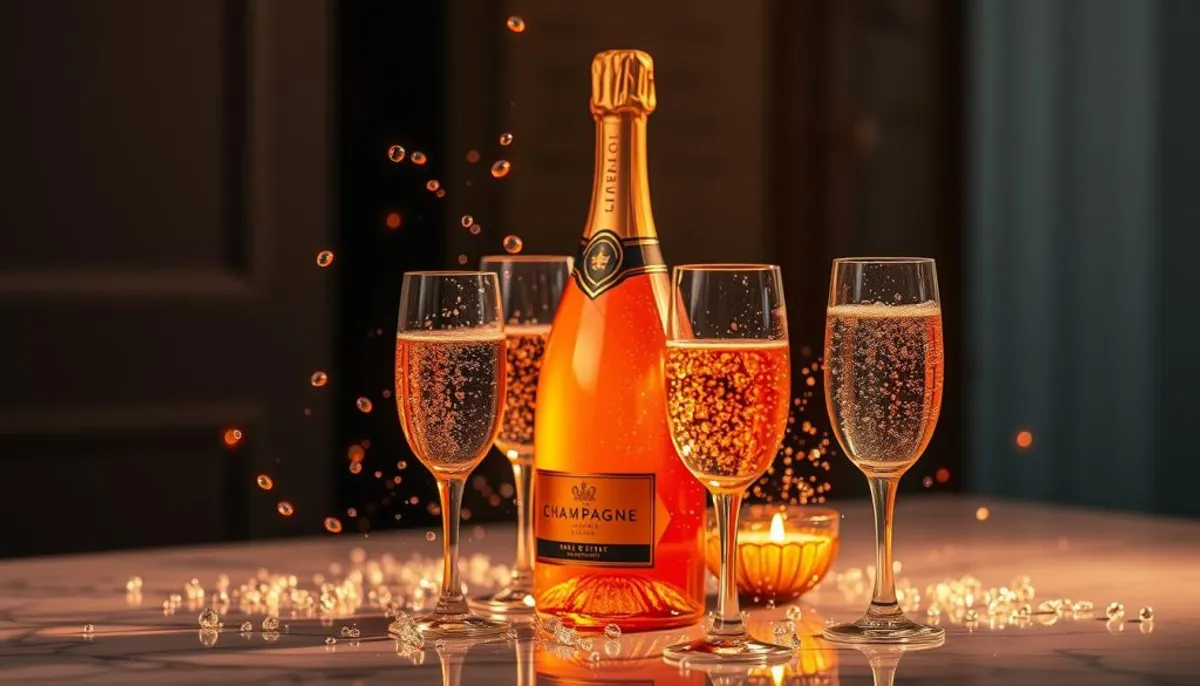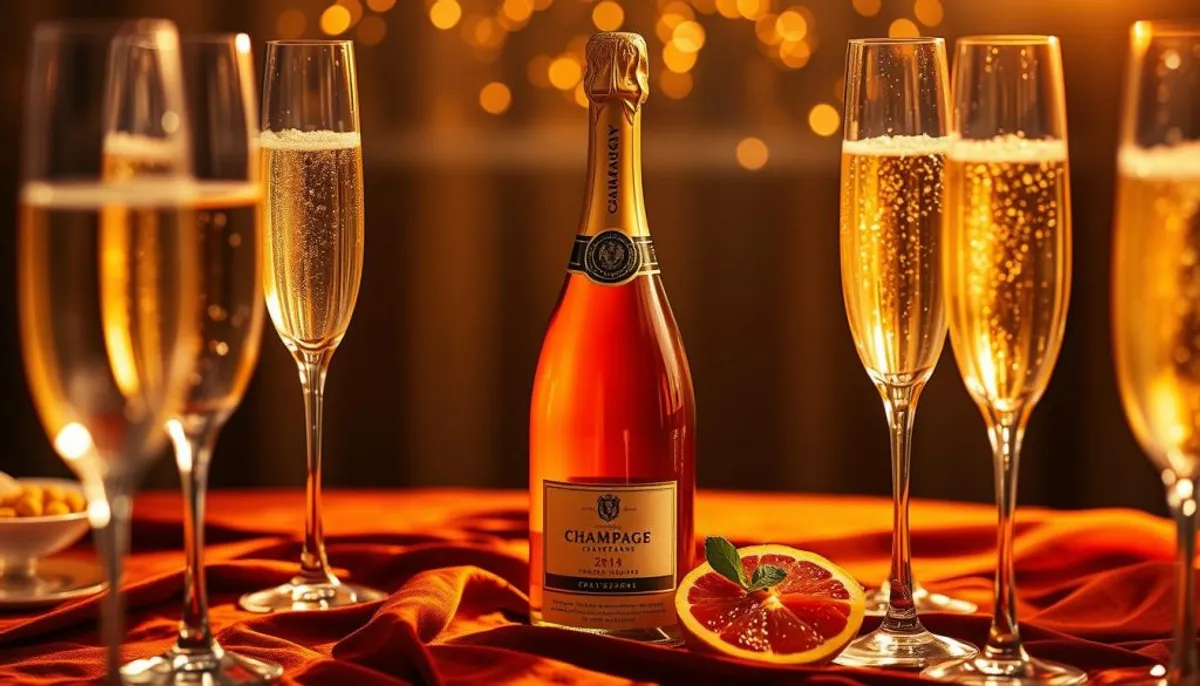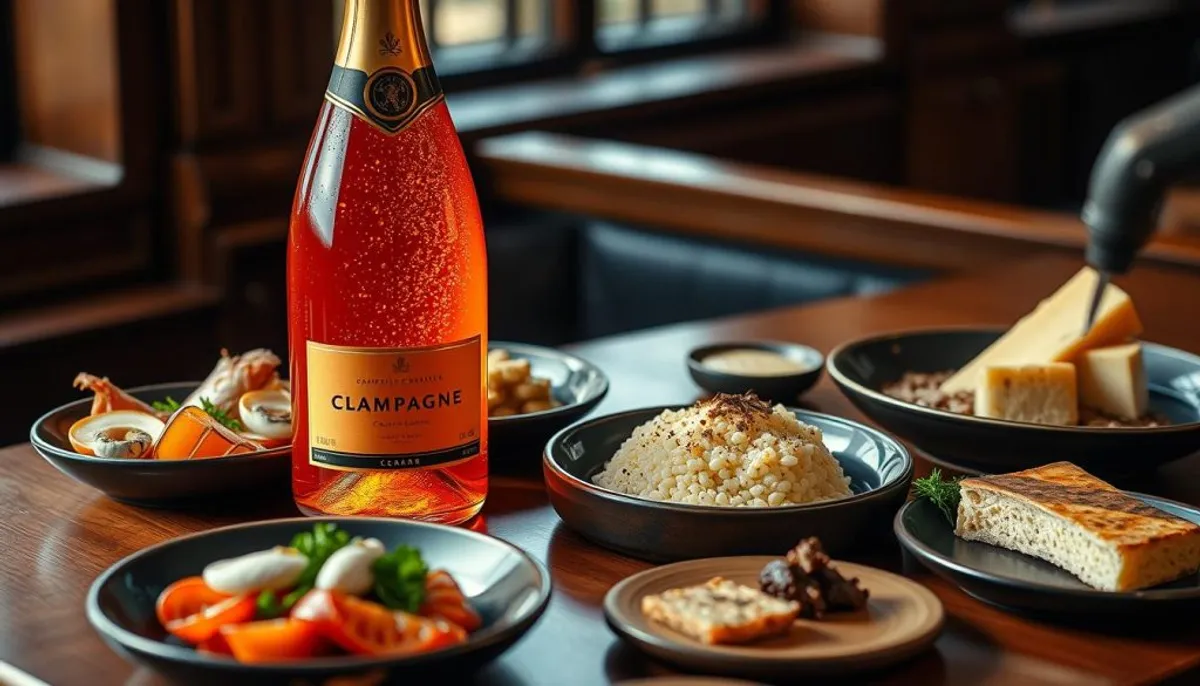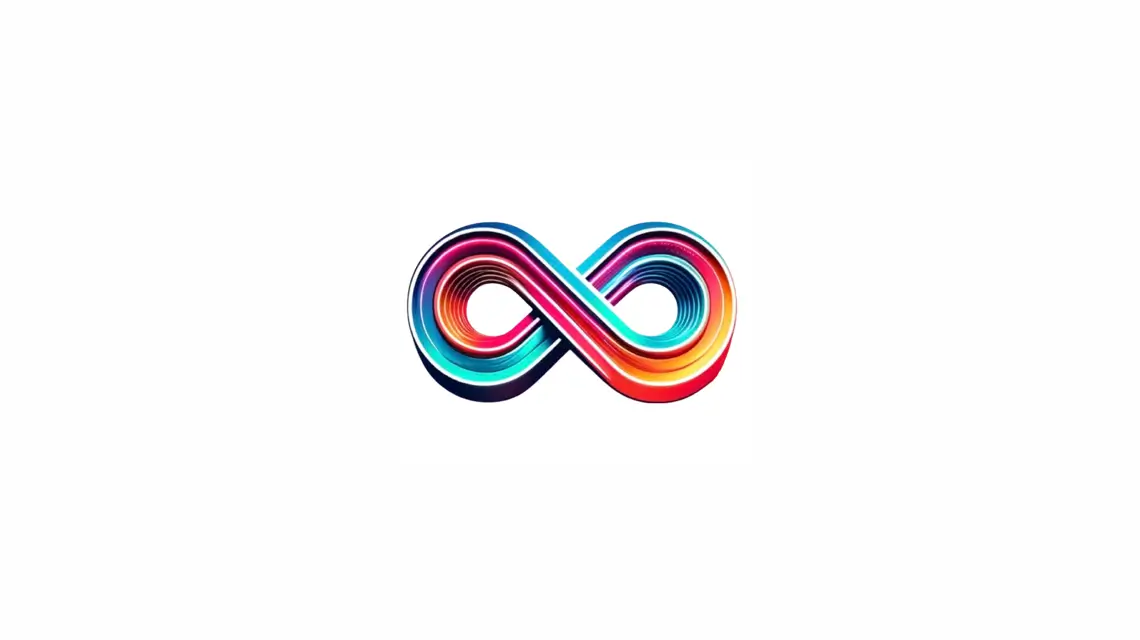
Enter the realm of premium champagne, where distinctive bottle designs captivate the senses. Luxury wine aficionados are captivated by the striking orange labels adorning some of the most coveted bottles. These orange-labeled treasures command attention on store shelves, promising a lavish experience with each sip.
Brands such as Veuve Clicquot have etched their names in history with their iconic orange packaging. This visual spectacle precedes the first sip, establishing a connection between the label and the champagne’s quality. It transcends mere taste, encompassing the entire ritual from uncorking to indulgence.
For those in pursuit of the ultimate luxury, Champagne Carbon presents a groundbreaking option. Their bottles boast a sleek carbon fiber design, blending tradition with modernity. This innovative packaging raises the bar for the premium champagne experience, attracting both collectors and connoisseurs.
Key Takeaways
- Orange labels signify luxury and uniqueness in champagne
- Distinctive bottle designs enhance the premium experience
- Veuve Clicquot is known for its iconic orange packaging
- Champagne Carbon introduces innovative carbon fiber bottles
- Luxury wine packaging appeals to collectors and enthusiasts
The Art of Luxury Champagne Making
Luxury champagne production is a fusion of ancient traditions and modern innovations. Renowned houses, such as Louis Roederer, have mastered this intricate balance. Their dedication to excellence begins in the vineyard and continues through each stage of winemaking.
Traditional Methods and Modern Innovation
Founded in 1776, Champagne Louis Roederer showcases the blend of tradition and innovation in winemaking. They cultivate 593 acres of vineyards, ensuring the highest quality grapes. Notably, they employ biodynamic farming on nearly 200 acres and organic methods on most, a rare practice in Champagne. For those looking to explore the area, there are many champagne region hotels that provide a perfect base for wine enthusiasts.
The Role of Terroir in Premium Champagne
Terroir is essential in crafting superior champagnes. The Champagne region, covering 34,000 hectares, is segmented into areas like Montagne de Reims and Cote des Blancs. Each segment contributes distinct traits to the grapes. For instance, Cristal, Roederer’s flagship, selects grapes from 45 elite parcels to capture the essence of the region’s limestone soils.
Aging Process and Its Impact
The aging process profoundly affects champagne’s complexity. Cristal, for example, ages on lees for at least 6 years, then undergoes additional aging post-disgorgement. This prolonged aging enhances the wine’s depth and subtlety. Expert Peter Liem advises aging Cristal for 10 to 20 years after release to fully appreciate its complexity, underscoring the value of patience in champagne appreciation.
| Champagne Style | Sugar Content (g/L) | Taste Profile |
|---|---|---|
| Brut Nature | 0-3 | Driest |
| Extra Brut | 0-6 | Very Dry |
| Brut | 0-12 | Dry |
| Extra Dry | 12-17 | Off-Dry |
| Sec | 17-32 | Slightly Sweet |
| Demi-Sec | 32-50 | Sweet |
Understanding Orange Champagne Bottle Design
Champagne bottle design has undergone significant transformations since the 17th century, when glass bottles became prevalent. The iconic packaging we admire today is a culmination of centuries of evolution. It seamlessly merges tradition with modern innovation.
Evolution of Iconic Packaging
The evolution of champagne bottle design is nothing short of captivating. In the 1970s, the E.U. standardized the 750mL bottle size, replacing the traditional 500mL Bordeaux bottle. Today, champagne bottles are crafted to endure the pressure of carbonization, ensuring the fizz remains intact.
Carbon Fiber Integration
The integration of carbon fiber marks a groundbreaking moment in champagne bottle design. This cutting-edge material infuses a sense of luxury, bridging the gap between premium champagnes and high-performance industries. The sleek, modern aesthetic of carbon fiber-wrapped bottles offers a distinctive visual appeal.
Visual Appeal and Brand Recognition
Orange has emerged as a quintessential color in champagne packaging. Brands such as Veuve Clicquot employ distinctive orange labels for instant brand recognition. This bold color, combined with unique bottle shapes for prestige cuvées, significantly enhances brand recognition. It also adds to the luxurious experience.
| Design Element | Purpose | Impact |
|---|---|---|
| Orange Color | Brand Distinction | Instant Recognition |
| Carbon Fiber | Luxury Appeal | Modern Aesthetic |
| Unique Shapes | Premium Positioning | Collector’s Value |
The evolution of champagne bottle design exemplifies how iconic packaging can significantly elevate brand recognition. It also enhances the overall luxury experience of premium champagnes, making it easier for consumers to find the best champagne deals in chandigarh.
Premium Champagne Tasting Notes
Champagne tasting transcends mere sensory experience, becoming an art form. Premium champagnes, with their intricate flavor profiles, captivate both aficionados and casual enthusiasts. Let’s dive into the subtleties of these luxurious effervescent beverages.
Aromatic Profile and Bouquet
The bouquet of a premium champagne is a symphony of scents. Notes of honey, toasted bread, and stewed fruits often emerge. Each sip unveils a cascade of aromas, evolving in the glass to tantalize the senses before the tasting begins.
Palate Experience and Texture
The palate experience of high-end champagne is characterized by its creamy, refined texture. Flavors from crisp apple to ripe pear grace the tongue. The silky texture, complemented by fine bubbles, offers a luxurious mouthfeel.
Finish and Aftertaste Characteristics
A premium champagne’s finish is memorable. It typically features a delicate acidity, balanced with the sweetness of candied citrus peel. This synergy creates an aftertaste that beckons for another sip, leaving a lasting impression.
| Champagne | Price | Characteristics |
|---|---|---|
| Taittinger La Francaise Brut | $69.99 | Crisp, balanced, with citrus notes |
| Laurent Perrier Brut | $49.99 | Fresh, elegant, with floral hints |
| Perrier Jouet Belle Epoque | $279.99 | Complex, refined, with fruity undertones |

Whether indulging in a Taittinger La Francaise Brut or treating oneself to a Perrier Jouet Belle Epoque, each champagne presents a distinct champagne tasting experience. The essence lies in savoring each sip, appreciating the meticulous craftsmanship that goes into these exquisite sparkling wines.
Exclusive Grape Selection and Blending
The art of crafting luxury champagne relies heavily on the selection of grapes and the blending process. Renowned champagne houses meticulously choose grapes from the finest vineyards to craft their unique blends. This process is akin to an art form, with winemakers dedicating themselves to finding the perfect balance through extensive tastings.
Chardonnay, Pinot Noir, and Meunier are the core components of most champagne blends. Each grape variety contributes distinct qualities to the final champagne. Chardonnay adds elegance and finesse, Pinot Noir provides body and structure, and Meunier brings fruitiness and roundness.
| Grape Variety | Characteristics | Typical Percentage in Blend |
|---|---|---|
| Chardonnay | Elegance, finesse | 20-100% |
| Pinot Noir | Body, structure | 30-100% |
| Meunier | Fruitiness, roundness | 5-40% |
The approach to blending varies among champagne houses. Some, like those producing prestigious cuvées, use grapes from specific parcels in top Champagne villages. Winemakers, such as Jean-Baptiste Lécaillon at Roederer, invest countless hours in perfecting their blends. They balance tradition with innovation to create exceptional champagnes.
This dedication to quality goes beyond just grape selection and blending. Champagne houses also prioritize data protection and continually refine their methods. Many celebrate long histories, like Charles Heidsieck’s bicentennial in 2022, while innovating to cater to diverse tastes and occasions.
The Perfect Serving Temperature and Glassware
Mastering the art of champagne service can significantly enhance your enjoyment of this luxurious beverage. We will explore the ideal serving temperature, the appropriate glassware, and presentation techniques to elevate your champagne experience.
Optimal Temperature Guidelines
The perfect temperature is crucial for bringing out the best in champagne. Most champagnes should be served between 6°C and 9°C for optimal flavor. This temperature range allows the flavors to shine while maintaining the effervescence. For full-bodied or vintage champagnes, slightly warmer temperatures of 10°C-12°C are recommended. This enhances their complex bouquets.
Choosing the Right Glass
The choice of glassware is vital for both the presentation and taste of champagne. Tulip-shaped flutes are a popular choice, as they preserve bubbles and concentrate aromas. For vintage or fuller-bodied champagnes, wider bowls are recommended to better appreciate complex flavors. Quality glassware not only enhances the visual appeal but also the tasting experience.
Serving Etiquette and Presentation
Proper presentation of champagne can elevate any occasion. Chill your bottle in an ice bucket for about 40 minutes before serving. Pour slowly, tilting the glass to preserve the bubbles. For an elegant touch, use a champagne cooler to maintain the ideal temperature throughout your event. Remember, presentation is key in luxury settings.
| Champagne Type | Ideal Serving Temperature | Recommended Glassware |
|---|---|---|
| Standard Brut | 6°C – 9°C | Tulip-shaped flute |
| Vintage/Full-bodied | 10°C – 12°C | Wide bowl glass |
| Rosé Champagne | 8°C – 10°C | Tulip-shaped flute or wide bowl |
Food Pairing Recommendations

Champagne pairing transcends mere accompaniment, elevating the culinary experience to new heights. The adaptability of premium champagnes positions them as the quintessential pairing for a broad spectrum of gourmet delights. Notably, Brut champagne, which comprised 73.9% of U.S. shipments in 2017, stands out for its unparalleled versatility.
Blanc de Blancs champagnes, crafted solely from white grapes, are celebrated for their crisp acidity and dryness. These attributes render them exceptionally compatible with seafood, creating a harmonious culinary synergy. For an indulgent pairing, consider the Perrier-Jouët Belle Epoque Blanc de Blancs ($361) with oysters, where the umami flavors meld in a symphony of taste.
Rosé champagne presents a distinct pairing opportunity. Peter Pan, the wine director, advocates for pairing duck with rosé champagne, as it enhances the dish’s flavors while mitigating its fattiness. For a more laid-back option, sommelier John Slover recommends brut rosé with margarita pizza, highlighting the acidity’s affinity with tomatoes and mozzarella.
| Champagne Type | Food Pairing | Price Range |
|---|---|---|
| Brut | Versatile, pairs with most dishes | $50 – $200 |
| Blanc de Blancs | Seafood, oysters | $35 – $361 |
| Rosé | Duck, pizza | $60 – $200 |
To elevate your gourmet food experience, consider pairing Charles Heidsieck Brut Réserve with rich dishes such as roast duck or smoked salmon. The intricate flavor profiles of premium champagnes beautifully complement a wide array of cuisines, making them the ideal choice for those seeking a refined culinary adventure.
Investment Value and Collectibility
The realm of champagne investment and wine collecting has witnessed significant expansion in recent years. What was once a luxury for special occasions has evolved into a valuable asset for astute investors.
Market Trends and Appreciation
Fine wine has outperformed many traditional investments. The Liv-ex Wine 100 index surged by 270.7% between 2001 and 2021, eclipsing the S&P 500 by 8%. Knight Frank’s 2021 Wealth Report highlights that fine wine appreciated 127% over ten years, outpacing luxury handbags and blue-chip art.
Storage Requirements
Proper storage is paramount for champagne investment. Experts advocate for bonded warehouses for optimal conditions and tax advantages. Maintaining consistent temperature and humidity is essential to preserve value and quality over time.
Authentication and Provenance
For dedicated collectors, authentication is paramount. Many leading champagne houses employ unique identifiers or special packaging to verify a bottle’s origin. This focus on provenance safeguards investments and guarantees authenticity.
Some notable performers in the market include:
- 2018 Screaming Eagle Cabernet Sauvignon: 56% price increase in one year
- 2009 Domaine de la Romanee-Conti Richebourg Grand Cru: 81% price jump over two years
With diligent research and care, champagne can serve as both a delightful indulgence and a shrewd investment.
Special Occasions and Celebrations
Premium champagne elevates ordinary moments into unforgettable memories. These luxurious bubbles are ideal for champagne celebrations, adding a touch of elegance to weddings, anniversaries, and corporate events. Brands like Charles Heidsieck and Philipponnat Royal Reserve Brut are renowned for their presence at high-profile gatherings globally.
Gifting champagne has evolved into an art form. The Louis Roederer Vintage Rosé, priced at $135, stands out as a remarkable gift. Its unique blend of 70% Cumières Pinot Noir and 30% Chouilly Chardonnay, aged for 4 years, embodies pure elegance. For those seeking a more affordable yet high-quality option, the Philipponnat Royal Reserve Brut at $85 offers excellent value.
Many champagne houses provide personalization options for gifting. From custom labels to engraved bottles, these details make the gift even more memorable. The Laurent-Perrier Rosé, with its distinct 100% Pinot Noir composition, is a favorite for romantic occasions.
| Champagne | Price | Best For |
|---|---|---|
| Charles Heidsieck Brut Reserve | $97 | Corporate Events |
| Louis Roederer Vintage Rosé | $135 | Weddings |
| Laurent-Perrier Rosé | $130 | Romantic Celebrations |
For truly special moments, consider a magnum bottle. These larger formats offer enhanced complexity due to increased glass surface area. They are perfect for milestone celebrations. Whether it’s a wedding toast or a New Year’s Eve party, premium champagne elevates any occasion to unforgettable heights.
Conclusion
The orange bottle champagne experience epitomizes the zenith of luxury within the wine realm. It encompasses the iconic Veuve Clicquot Yellow Label and other premium bubbly varieties, merging tradition with innovation. The Veuve Clicquot blend exemplifies champagne craftsmanship, combining 50-55% Pinot Noir, 15-20% Pinot Meunier, and 28-33% Chardonnay from 50 to 60 different Crus.
This luxury extends beyond the bottle. It encompasses the rich history, such as Barbe-Nicole Ponsardin’s leadership of Maison Veuve Clicquot at 27 and her invention of the riddling table in 1816. It also highlights the meticulous craftsmanship, with houses like Krug maintaining five million bottles in their cellar. The evolution towards drier styles since the ’90s and the increasing popularity of rosé champagne production further underscore this luxury.
Whether enjoying a $26 Prosecco or a premium bubbly like the Charles Heidsieck Brut Réserve “200 Years of Liberty” at $65, each sip is a unique experience. Madame de Pompadour’s words, “champagne is the only wine that leaves a woman more beautiful after drinking it,” encapsulate the allure of orange bottle champagne. It is a fusion of luxury, history, and timeless appeal.
RelatedRelated articles



